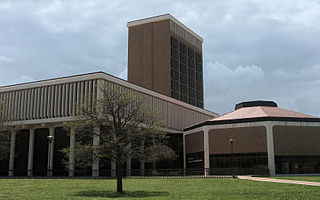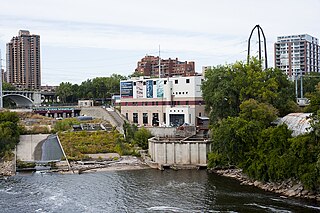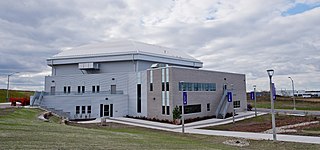
The Ames Research Center (ARC), also known as NASA Ames, is a major NASA research center at Moffett Federal Airfield in California's Silicon Valley. It was founded in 1939 as the second National Advisory Committee for Aeronautics (NACA) laboratory. That agency was dissolved and its assets and personnel transferred to the newly created National Aeronautics and Space Administration (NASA) on October 1, 1958. NASA Ames is named in honor of Joseph Sweetman Ames, a physicist and one of the founding members of NACA. At last estimate NASA Ames had over US$3 billion in capital equipment, 2,300 research personnel and a US$860 million annual budget.

Sandia National Laboratories (SNL), also known as Sandia, is one of three research and development laboratories of the United States Department of Energy's National Nuclear Security Administration (NNSA). Headquartered in Kirtland Air Force Base in Albuquerque, New Mexico, it has a second principal facility next to Lawrence Livermore National Laboratory in Livermore, California, and a test facility in Waimea, Kauai, Hawaii. Sandia is owned by the U.S. federal government but privately managed and operated by National Technology and Engineering Solutions of Sandia, a wholly owned subsidiary of Honeywell International.
The Fujita scale, or Fujita–Pearson scale, is a scale for rating tornado intensity, based primarily on the damage tornadoes inflict on human-built structures and vegetation. The official Fujita scale category is determined by meteorologists and engineers after a ground or aerial damage survey, or both; and depending on the circumstances, ground-swirl patterns, weather radar data, witness testimonies, media reports and damage imagery, as well as photogrammetry or videogrammetry if motion picture recording is available. The Fujita scale was replaced with the Enhanced Fujita scale (EF-Scale) in the United States in February 2007. In April 2013, Canada adopted the EF-Scale over the Fujita scale along with 31 "Specific Damage Indicators" used by Environment Canada (EC) in their ratings.

Texas Tech University is a public research university in Lubbock, Texas. Established on October 2, 1923, and called Texas Technological College until 1969, it is the flagship institution of the five-institution Texas Tech University System. As of Fall 2023, the university enrolled 40,944 students, making it the sixth-largest university in Texas. Over 25% of its undergraduate student population identifies as Hispanic, so the university has been designated a Hispanic-serving institution (HSI).

Tetsuya Theodore Fujita was a Japanese-American meteorologist whose research primarily focused on severe weather. His research at the University of Chicago on severe thunderstorms, tornadoes, hurricanes, and typhoons revolutionized the knowledge of each. Although he is best known for creating the Fujita scale of tornado intensity and damage, he also discovered downbursts and microbursts and was an instrumental figure in advancing modern understanding of many severe weather phenomena and how they affect people and communities, especially through his work exploring the relationship between wind speed and damage.

Portions of Lubbock, Texas, were struck by a powerful multiple-vortex tornado after nightfall on May 11, 1970, resulting in 26 fatalities and an estimated $250 million in damage. It was in its time the costliest tornado in U.S. history, damaging nearly 9,000 homes and inflicting widespread damage to businesses, high-rise buildings, and public infrastructure. The tornado's damage was surveyed by meteorologist Ted Fujita in what researcher Thomas P. Grazulis described as "the most detailed mapping ever done, up to that time, of the path of a single tornado." Originally, the most severe damage was assigned a preliminary F6 rating on the Fujita scale, making it one of only two tornadoes to receive the rating, alongside the 1974 Xenia tornado. Later, it was downgraded to an F5 rating. The extremity of the damage and the force required to displace heavy objects as much as was observed indicated that winds produced by vortices within the tornado may have reached as high as 290 mph (470 km/h).

A storm shelter or storm cellar is a type of underground bunker designed to protect the occupants from violent severe weather, particularly tornadoes. They are most frequently seen in the Midwest and Southeastern United States where tornadoes are generally frequent and the low water table permits underground structures.

Tennessee Technological University is a public research university in Cookeville, Tennessee. It was formerly known as Tennessee Polytechnic Institute, and before that as University of Dixie, the name under which it was founded as a private institution. Affiliated with the Tennessee Board of Regents, the university is governed by a board of trustees. It is classified among "R2: Doctoral Universities – High research activity".
The Enhanced Fujita scale rates tornado intensity based on the severity of the damage they cause. It is used in some countries, including the United States and France. The EF scale is also unofficially used in other countries, including China.
The Aerospace, Transportation and Advanced Systems Laboratory (ATAS) is one of eight labs in the Georgia Tech Research Institute and one of three labs under the Sensors and Intelligent Systems directorate. ATAS develops advanced systems concepts and performs research related to aerospace systems, power and energy systems, threat systems, intelligent autonomous systems, and systems engineering methodologies. The lab also develops advanced technologies and performs research in a range of areas relevant to aerospace and ground transportation as well as to national defense.

The Texas Tech University School of Law is an ABA-accredited law school located on the campus of Texas Tech University in Lubbock, Texas. The school offers three academic centers, ten dual-degree programs, a nationally recognized legal writing program, and a competitive advocacy program that has earned 45 national and international championships. Additionally, third-year law students may participate in one of the school's eight clinical programs, which allow students to gain real-world experience while providing free legal representation to low-income individuals. The school focuses on forming practical lawyers who are ready to practice law upon graduation. The student population is approximately 60.4% male and 39.6% female.

Tornado intensity is the measure of wind speeds and potential risk produced by a tornado. Intensity can be measured by in situ or remote sensing measurements, but since these are impractical for wide-scale use, intensity is usually inferred by proxies, such as damage. The Fujita scale, Enhanced Fujita scale, and the International Fujita scale rate tornadoes by the damage caused. In contrast to other major storms such as hurricanes and typhoons, such classifications are only assigned retroactively. Wind speed alone is not enough to determine the intensity of a tornado. An EF0 tornado may damage trees and peel some shingles off roofs, while an EF5 tornado can rip well-anchored homes off their foundations, leaving them bare— even deforming large skyscrapers. The similar TORRO scale ranges from a T0 for extremely weak tornadoes to T11 for the most powerful known tornadoes. Doppler radar data, photogrammetry, and ground swirl patterns may also be analyzed to determine the intensity and assign a rating.

The Edward E. Whitacre Jr. College of Engineering is the college of engineering at Texas Tech University in Lubbock, Texas. The engineering program has existed at Texas Tech University since 1925. Additionally, the Whitacre College of Engineering administers graduate engineering degree programs at the university's campus in Amarillo, Texas. Many of the college's degree programs are accredited by ABET. The Whitacre College of Engineering is the first and, presently, only school in the world to offer a doctor of philosophy degree in wind science and engineering.

Texas Tech University College of Media & Communication provides faculty, staff and students opportunities to study communications-related disciplines. The college is located on the sprawling Texas Tech University campus in Lubbock, Texas. TTU CoMC features seven undergraduate programs as well as a doctoral program and three master's degree programs.

Reese Technology Center is a research and business park located on the grounds of former Reese Air Force Base in western Lubbock at the unincorporated community of Reese Center.

The Saint Anthony Falls Laboratory, or SAFL, is a research laboratory situated on Hennepin Island in the Mississippi River in Minneapolis, Minnesota, United States. Its primary research is in "Engineering, Environmental, Biological, and Geophysical Fluid Mechanics". It is affiliated with the University of Minnesota's College of Science and Engineering. Research is conducted by graduate students and faculty alike using the 16,000 square feet of research space and 24 different specialized facilities.

The Wind Engineering, Energy and Environment (WindEEE) Dome is a hexagonal-shaped vertical wind tunnel proposed for the University of Western Ontario. It is designed to simulate localized, high-intensity wind patterns such as downbursts and tornadoes that have never been studied before.
The following is a glossary of tornado terms. It includes scientific as well as selected informal terminology.

The College of Engineering is a college within the University of Notre Dame. The Dean of the College of Engineering is Patricia J. Culligan, Ph.D. Its graduate school for Engineering is ranked #47 in the USA and #15 for undergraduate.
The Scaled Wind Farm Technology (SWiFT) Facility is a collaborative research facility, located at the Reese Technology Center in Lubbock, Texas. It is the first facility to offer multiple wind turbines to measure turbine performance in a wind farm environment for as a user facility for the Wind Energy Technologies Office of the United States Department of Energy. The project was formally commissioned in summer 2013.















